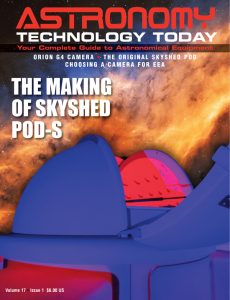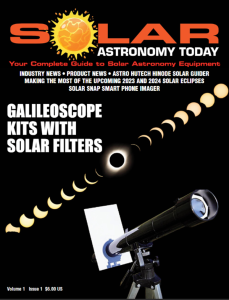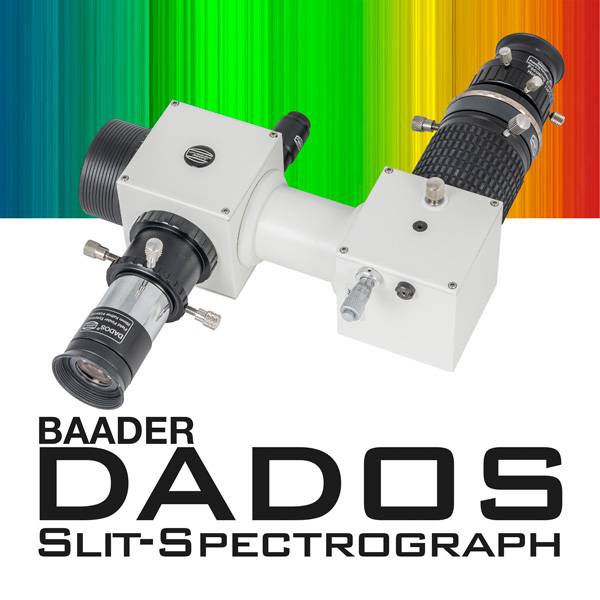The Baader Triband Solar SCT line of telescopes offers a Schmidt Cassegrain design using a Celestron SCT tube for both solar as well night-time astronomy use.
 The Baader Triband Solar SCT’s are available in apertures of 8″, 9.25″ and 11″ and feature a Celestron Schmidt Cassegrain optical tube assembly with a Triband ERF (energy rejection filter) coated Schmidt corrector plate and rear ventilated heat shields (with Neodymium-magnetic holders) to keep the tube and secondary mirror cool.
The Baader Triband Solar SCT’s are available in apertures of 8″, 9.25″ and 11″ and feature a Celestron Schmidt Cassegrain optical tube assembly with a Triband ERF (energy rejection filter) coated Schmidt corrector plate and rear ventilated heat shields (with Neodymium-magnetic holders) to keep the tube and secondary mirror cool.
To observe fine and faint solar features, sufficient aperture and focal length are required making SCT’s an ideal “original source telescope”. The Baader Triband Solar SCT lineup offers the energy rejection filter (ERF) “integrated” into the optical coatings of the Triband Schmidt corrector plate to enable solar astronomy using SolarSpectrum CaK and H-alpha filters. In the infrared, the Triband-coated Schmidt corrector is blocked down to 1450nm reflecting more than 90 percent of the incoming light, so that the telescope will not heat up. The rear-ventilated heat shields on the front of the telescope tube and on the secondary mirror holder also keep the tube from heating up during solar viewing.
These features allow the use of the full aperture and optical quality of the Schmidt corrector to give the highest resolution and best possible views (and images) of the Sun. With videography it is possible to achieve extremely high-resolution detail images of the Sun and can be accomplished at three (triband) wavelengths – not only in H-alpha. The transmission windows of the ERF are designed for Calcium-K, Continuum (incl H-beta and O III), H-alpha and S II and also can accommodate additional narrowband filters for nighttime use.
For the following uses, you need further equipment:
Baader Triband Solar SCT for H-alpha
Needed: Solar Spectrum H-alpha filter, TZ-3 telecentric system and telecompressor TK0.4 or TK0.7. An additional D-ERF filter is not required.
The Baader Triband Solar SCT lineup was developed for the SolarSpectrum H-alpha filters. The Energy Rejection Filter which is integrated into the Schmidt corrector plate eliminates the need for an additional D-ERF. The SolarSpectrum filters require the Badder 2″ Research Grade TZ-3 Telecentric System (3x focal length), to perform at its best at f/30; with the Research Grade H-alpha 0.4x Telecompressor 2″ for Solar Spectrum with 16mm corrected field of view, you almost regain the original focal length of the telescope and can work both visually and photographically at lower magnifications.
Baader Triband Solar SCT for CaK
Needed: Solar Spectrum CaK-filter, Calcium CaK filter plus additional front filter for observing the Sun in CaK.
In addition to the transmission window between 630 and 680 nm for H-alpha observation, the Energy Rejection Filter has a second window between 380 and 400 nm, in the dark blue/UV. It is made for using SolarSpectrum CaK filters without an additional Energy Rejection Filter.
The Baader K-Line Filter 1¼” (double stacked) filter can be used, but only behind another filter such as a Baader Safety CoolCeramic Herschel Prism 2″ Photographic or AstroSolar photo film ND 3.8 (also available as BDSF: OD 3.8 Baader Digital Solar Filter 200mm in matching mount).
Baader Triband Solar SCT for White Light
Needed: Safety Cool-Ceramic Herschel prism plus optional narrowband filters.
Solar observation in white light can be done with a Baader Safety CoolCeramic Herschel Prism 2″ Photographic or a temperature-compensating ASTF front filter made of astrosolar film. The Sun appears slightly light green. For increased contrast, Baader recommends a red filter like the Baader H-alpha 2″ Bandpass filter (20nm) to reduce the influence of seeing, or the O-III 2″ Super-G Filter (9nm) – CMOS optimized.
Baader Triband Solar SCT for Deep-Sky
The Triband-SCTs are based on Celestron’s Schmidt-Cassegrains, a well-tried, robust and reliable telescope system. That’s why they are also compatible with a multitude of accessories which was developed for regular Schmidt-Cassegrains – starting with filter drawers like the UFC or focusers like the Baader Diamond SteelTrack with optional motor focuser or the Celestron Fokussiermotor up to reducers.
Unlike pure H-alpha-telescopes, the Triband-SCT can be used at night. The coating is permeable for CaK, H-Beta, O-III, H-alpha and S-II, so that you can use the telescope fully for narrowband – or Ultra UHC-photography – be it with the original f/10, at night with a reducer or even with a Hyperstar-system at f/2. UV-filters such as the Baader U-Venus-Filter 2″ (350nm) or IR-Pass-Filters Baader IR-Pass Filter 1¼” (685 nm) can be used and achieve surprisingly good contrast. The SC optical system suffers much less from chromatic aberration over a much broader spectral range than most apochromatic lens telescopes. This makes the Triband-SCT’s among the most versatile CaK and H-alpha-telescopes on the market.
You can learn more about the Baader Triband Solar SCT here.

 And to make it easier for you to get the most extensive news, articles and reviews that are only available in the magazine pages of Astronomy Technology Today, we are offering a 1-year magazine subscription for only $6! Or, for an even better deal, we are offering 2 years for only $9. Click here to get these deals which only will be available for a very limited time. You can also check out a free sample issue here.
And to make it easier for you to get the most extensive news, articles and reviews that are only available in the magazine pages of Astronomy Technology Today, we are offering a 1-year magazine subscription for only $6! Or, for an even better deal, we are offering 2 years for only $9. Click here to get these deals which only will be available for a very limited time. You can also check out a free sample issue here.
The Sun is more active than it’s been in years and if that’s not enough, we have the Annular Solar Eclipse on October 14, 2023 and the Total Solar Eclipse on April 8, 2024! If you’d like to learn more about the technology behind solar observing, solar imaging and more, you can check out our new monthly magazine – Solar Astronomy Today. It’s free to read, no subscription needed and available here. And if you are preparing for the upcoming eclipses and want to know your equipment options from solar glasses to the most out of this world solar viewing and imaging options, check out our free publication – The Definitive Guide to Viewing and Imaging the Sun – simply click here and enjoy reading!



